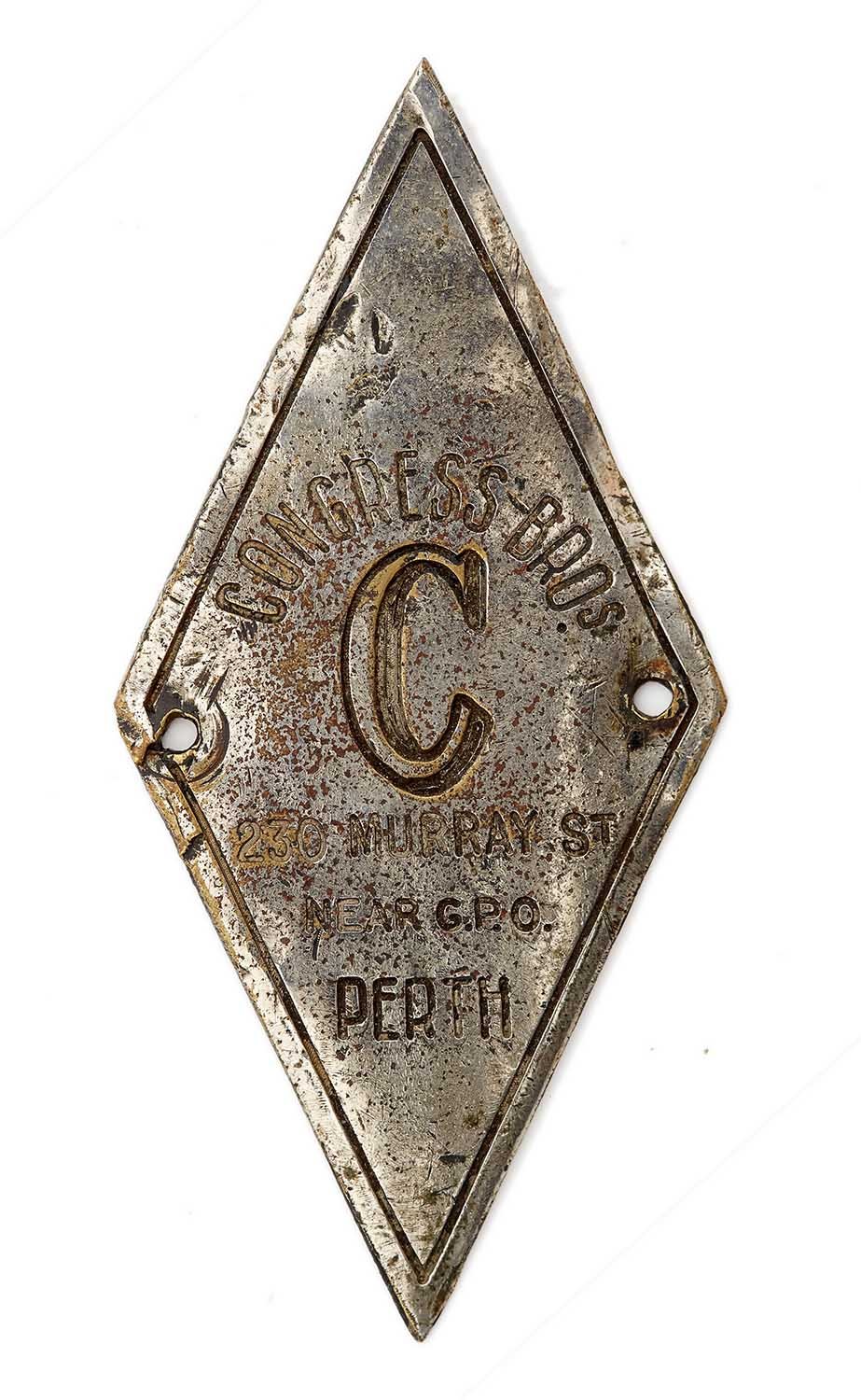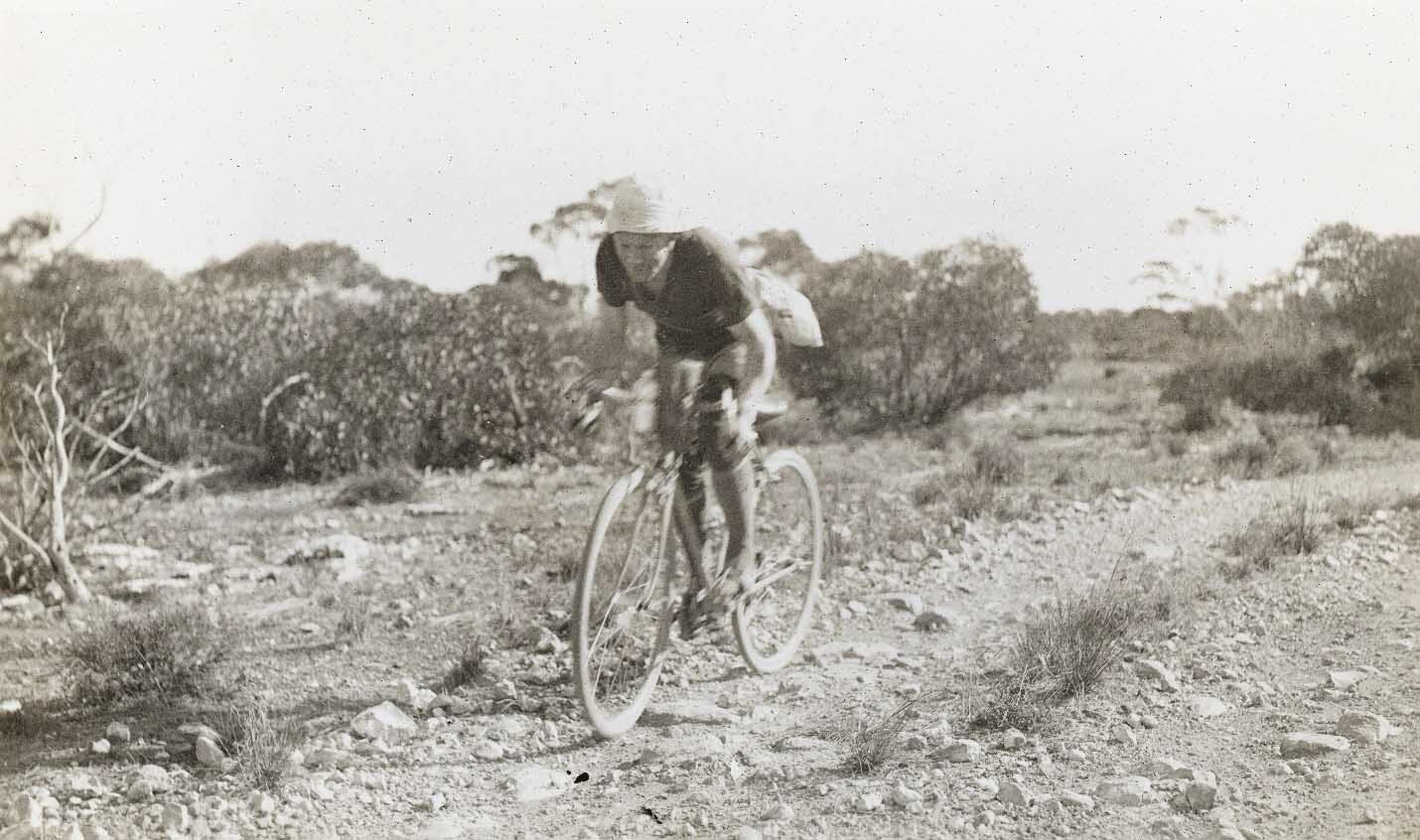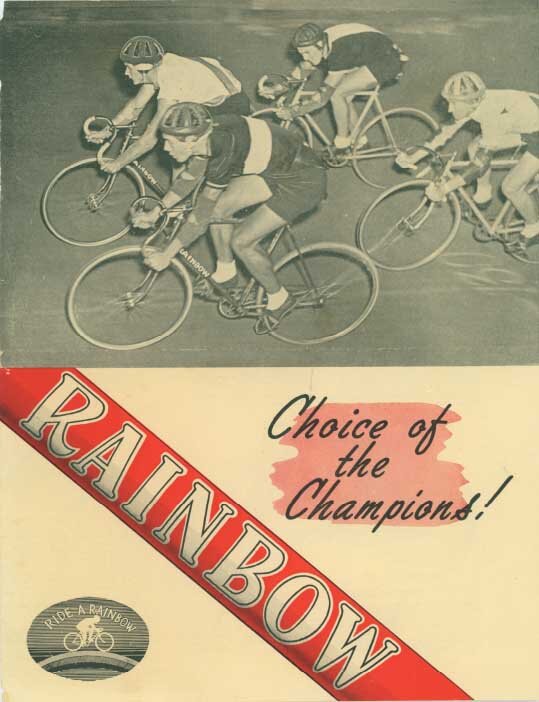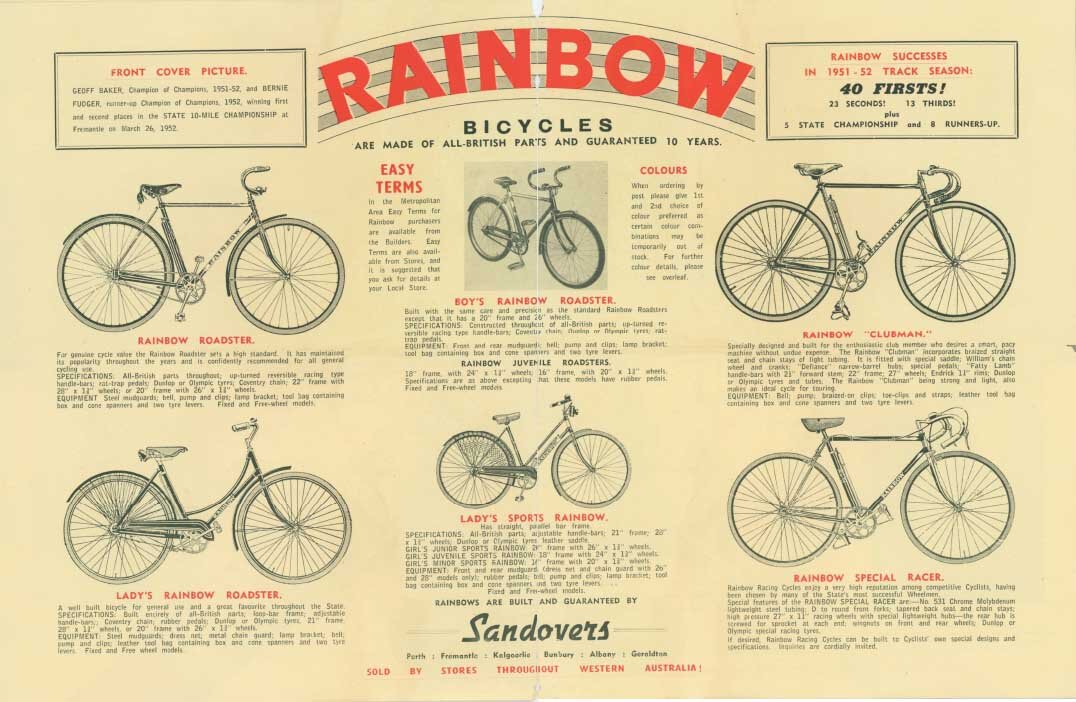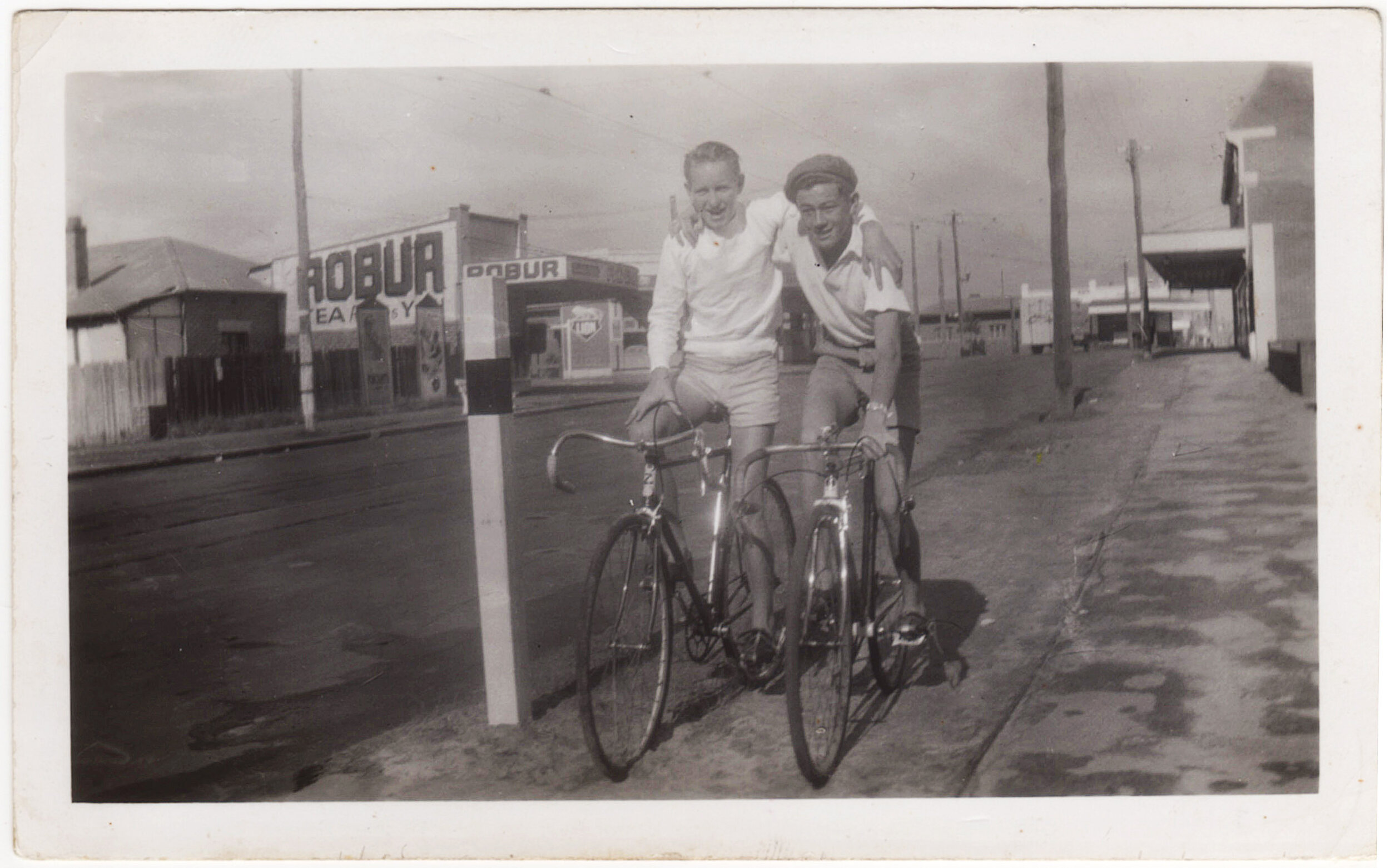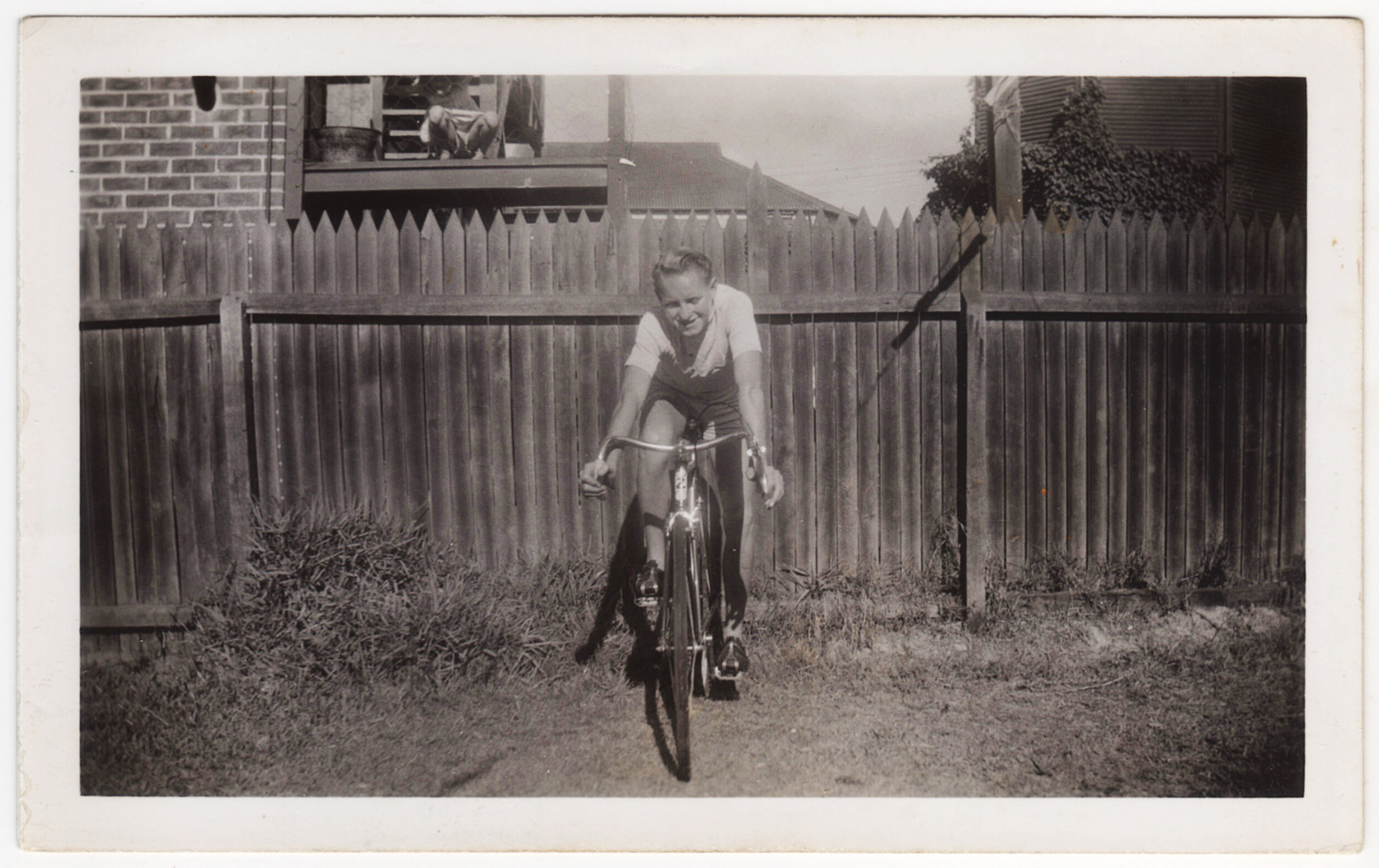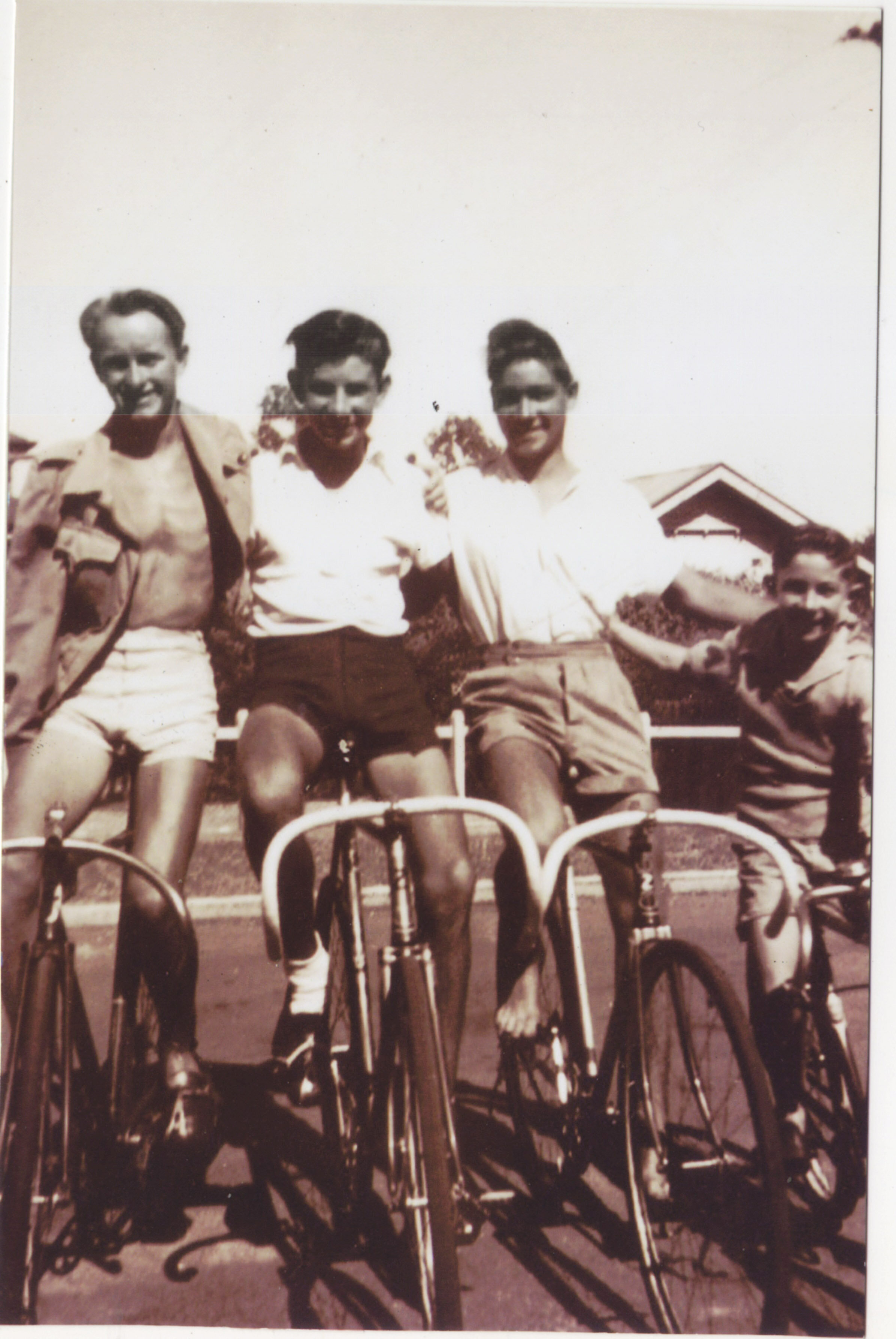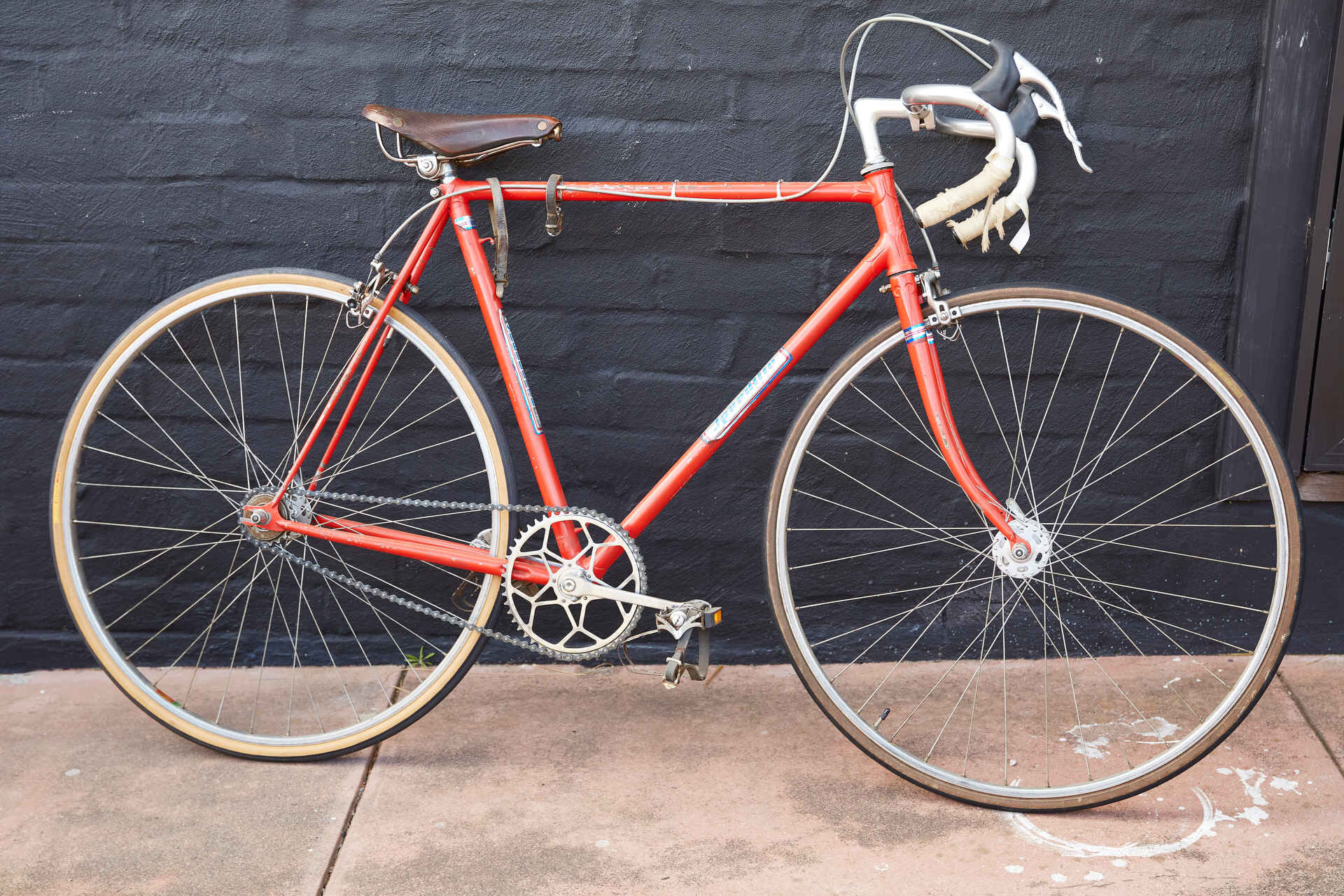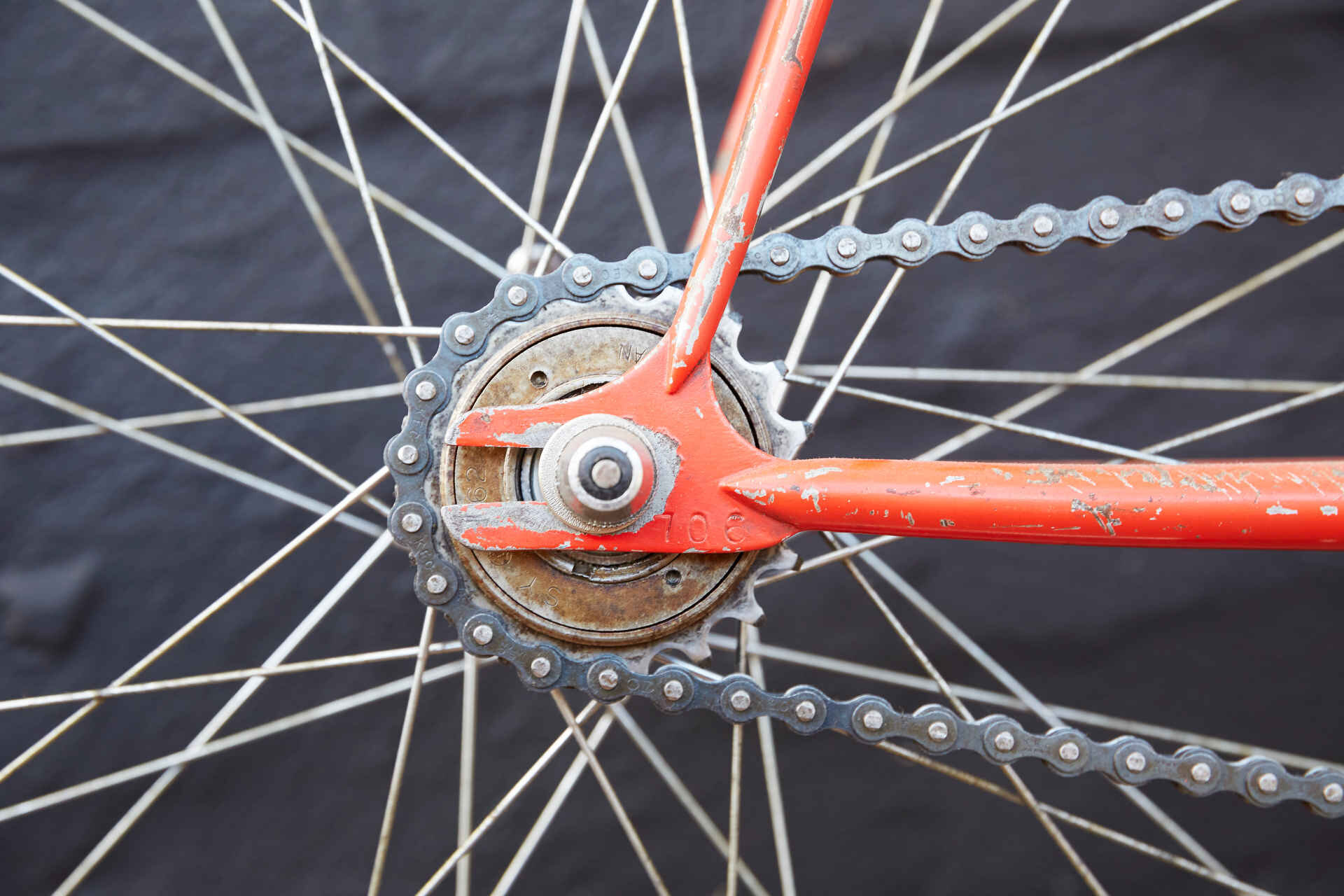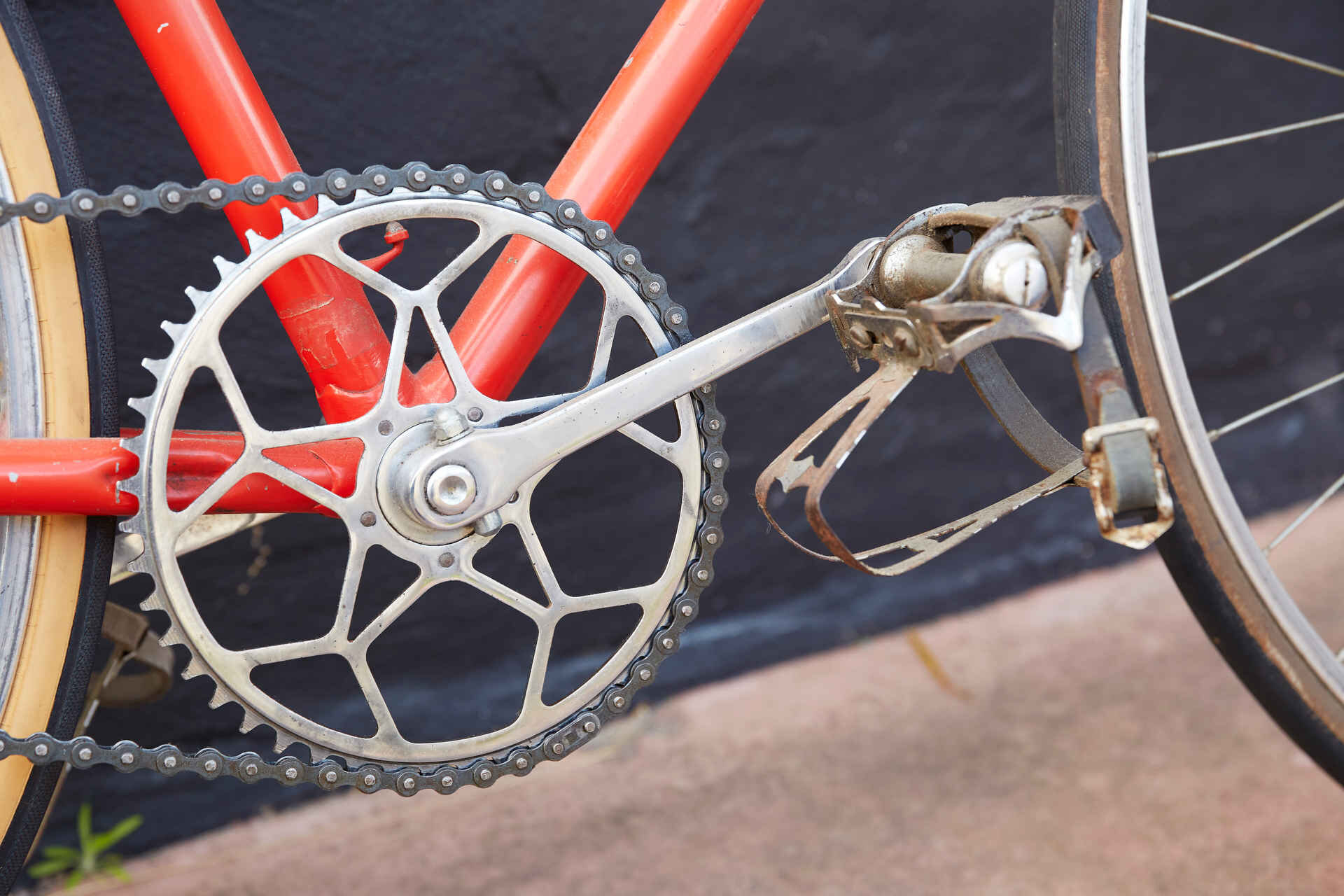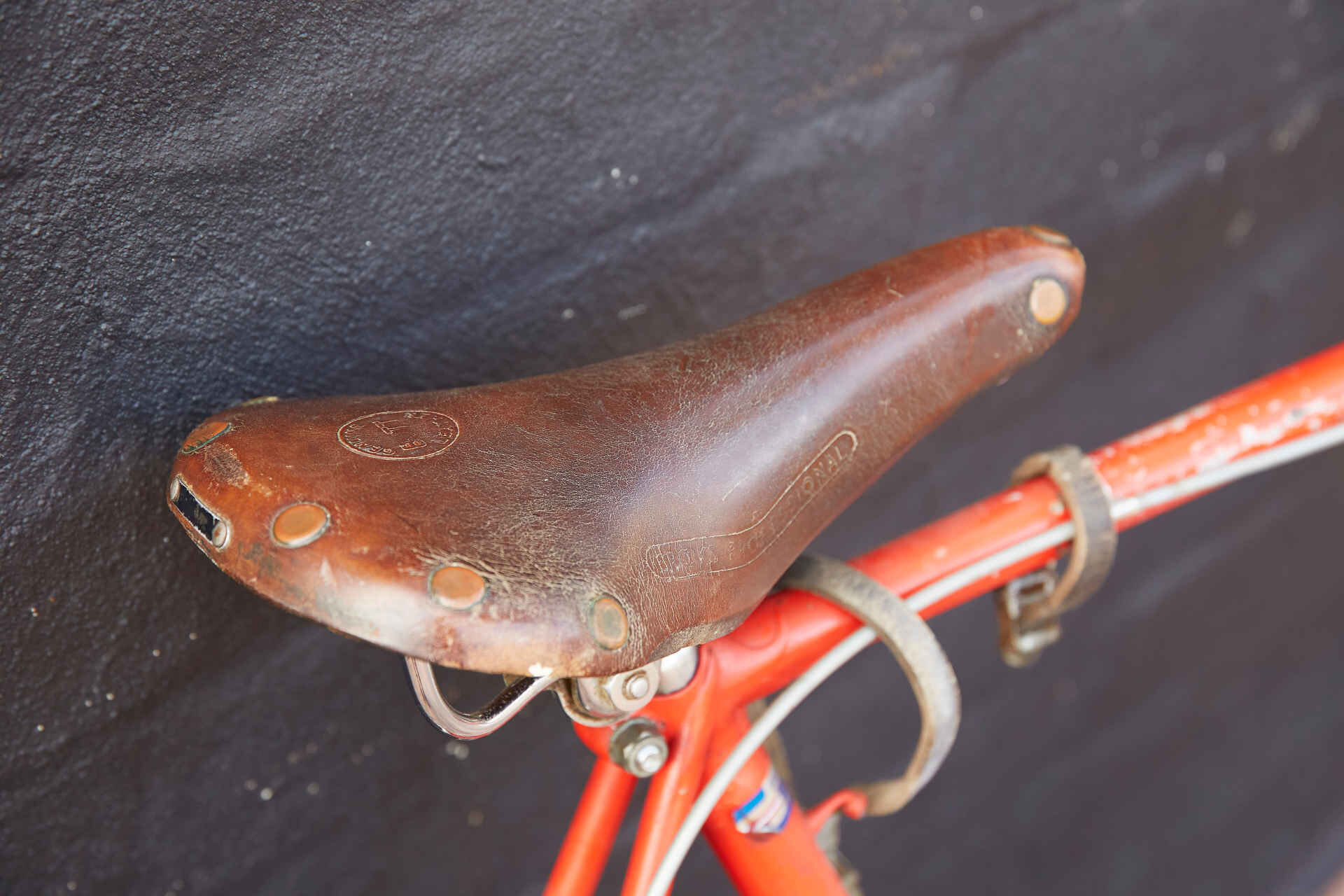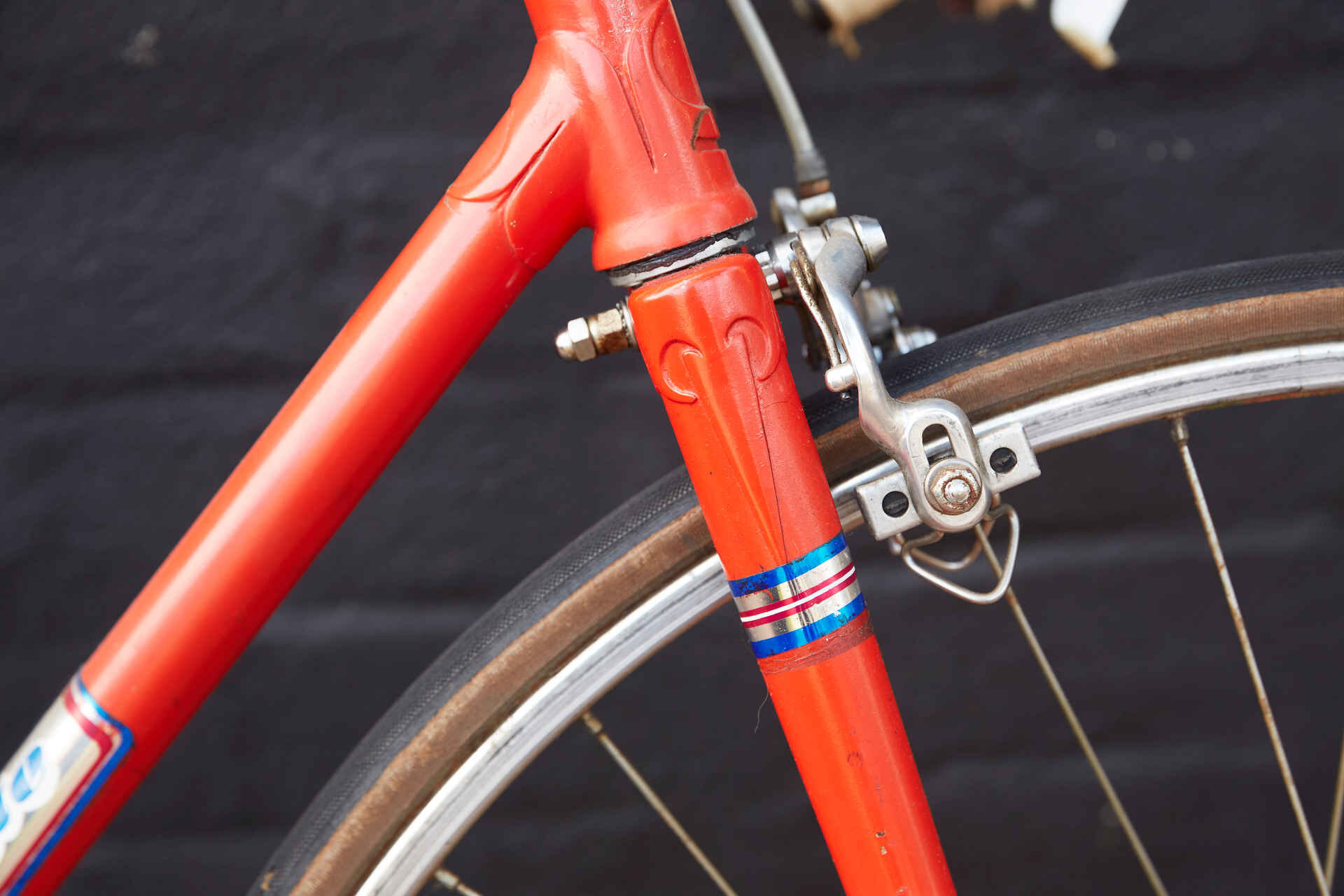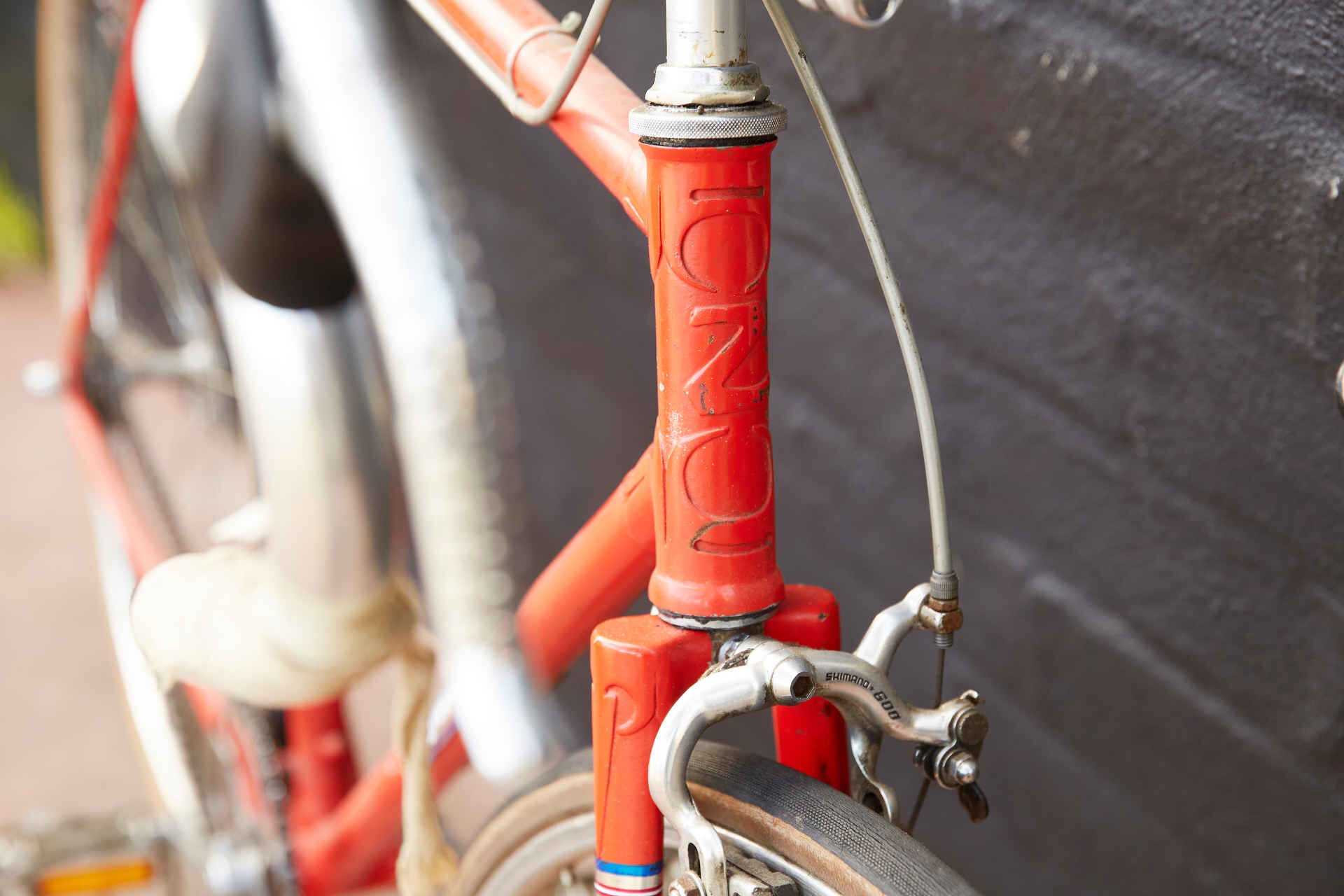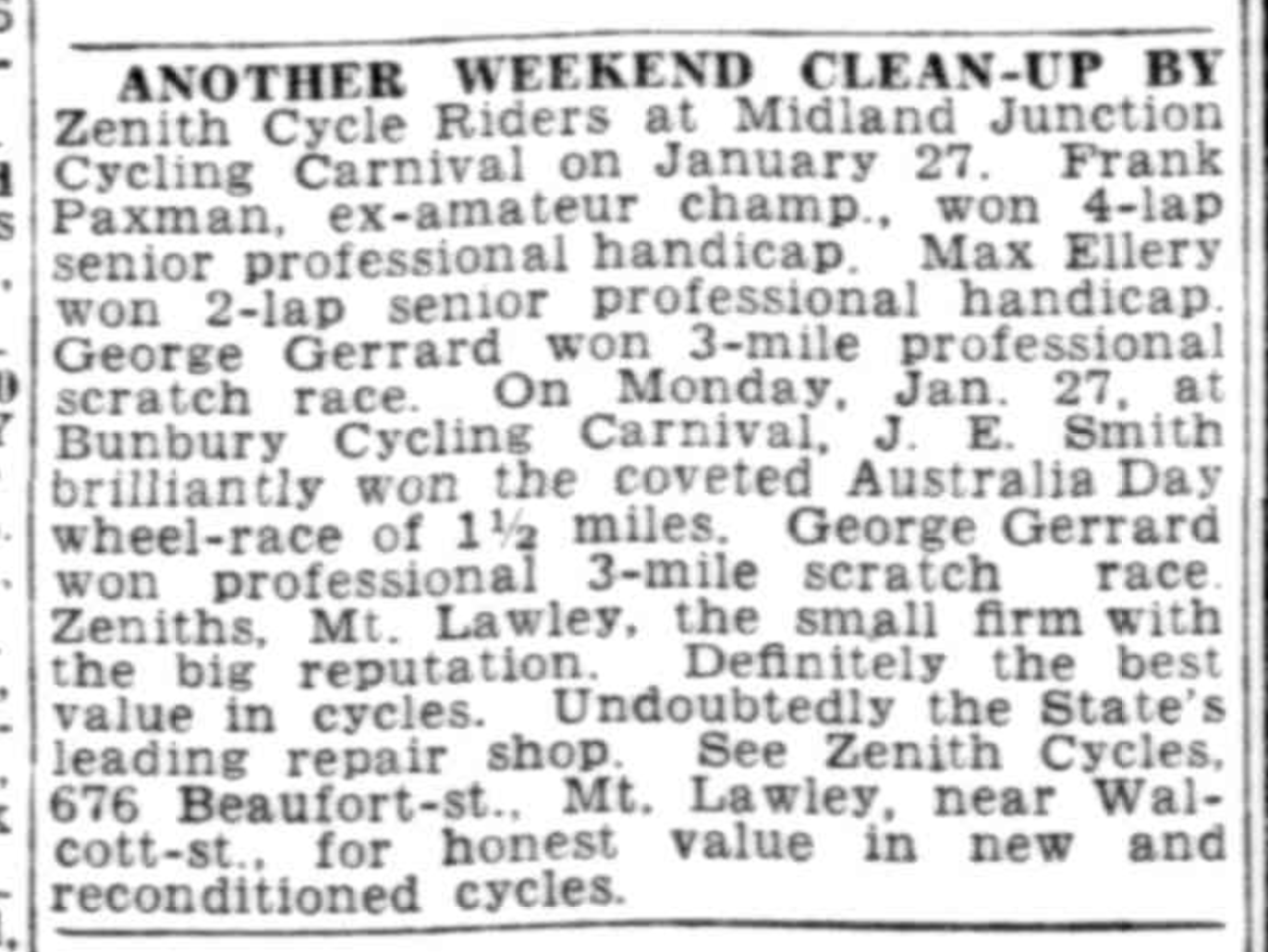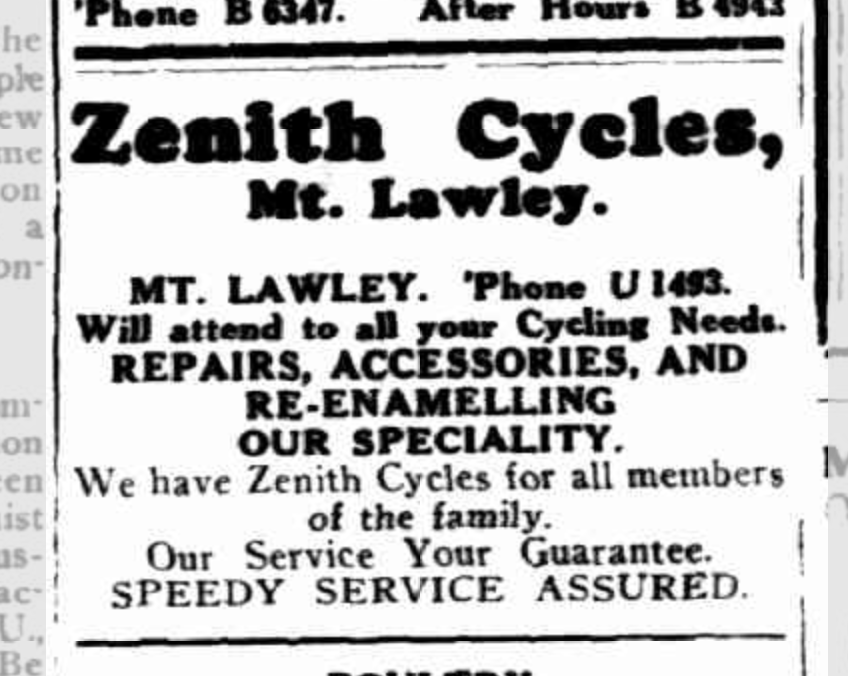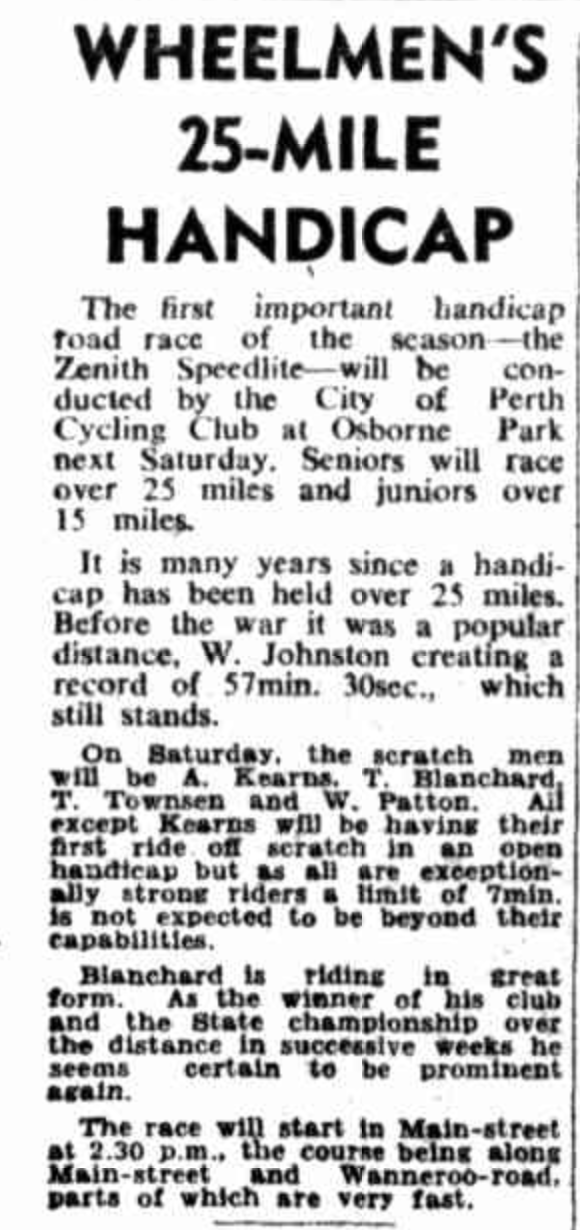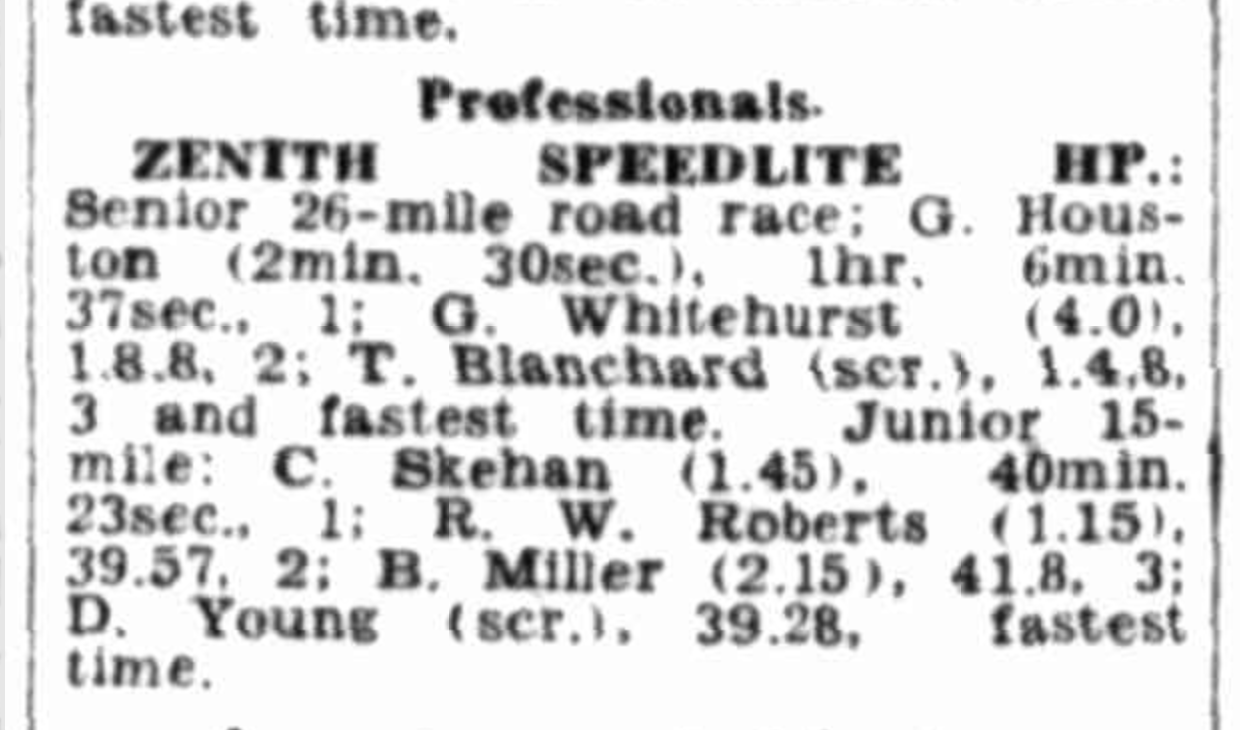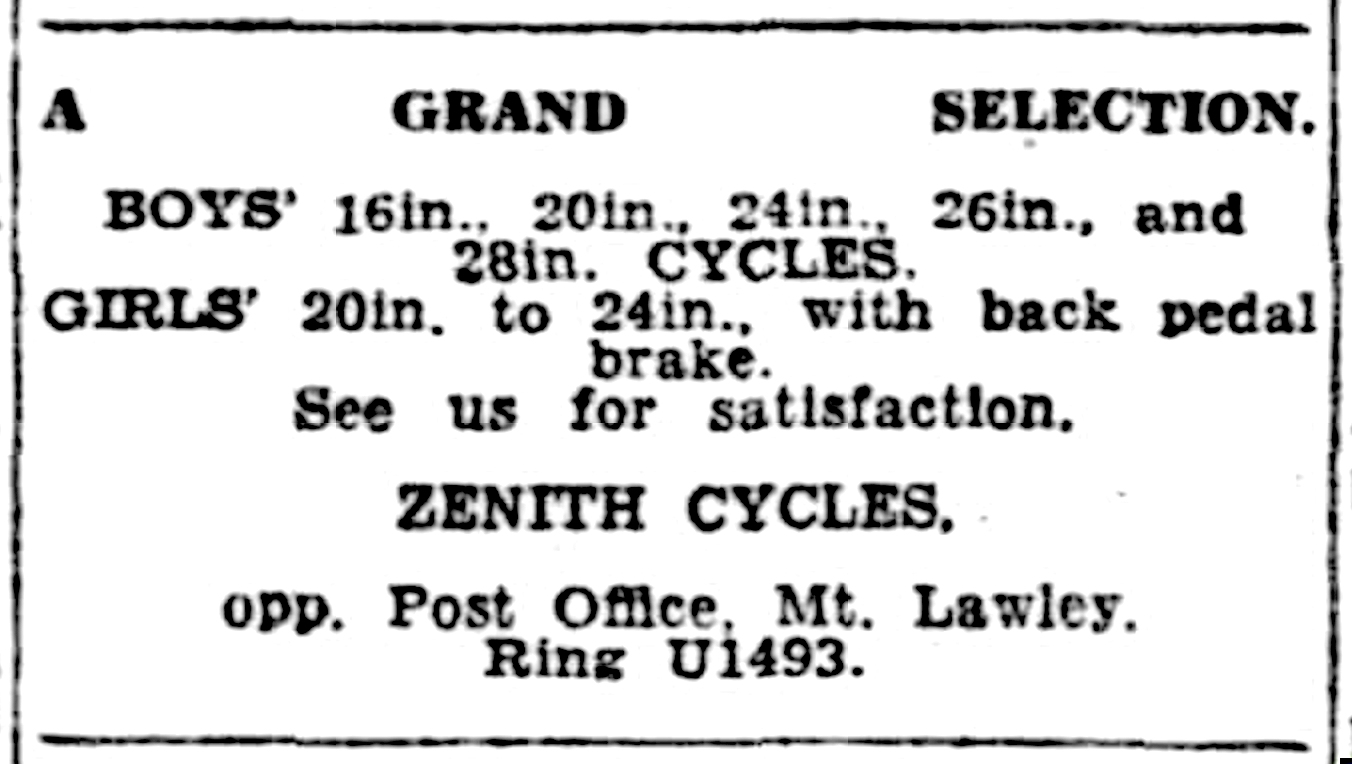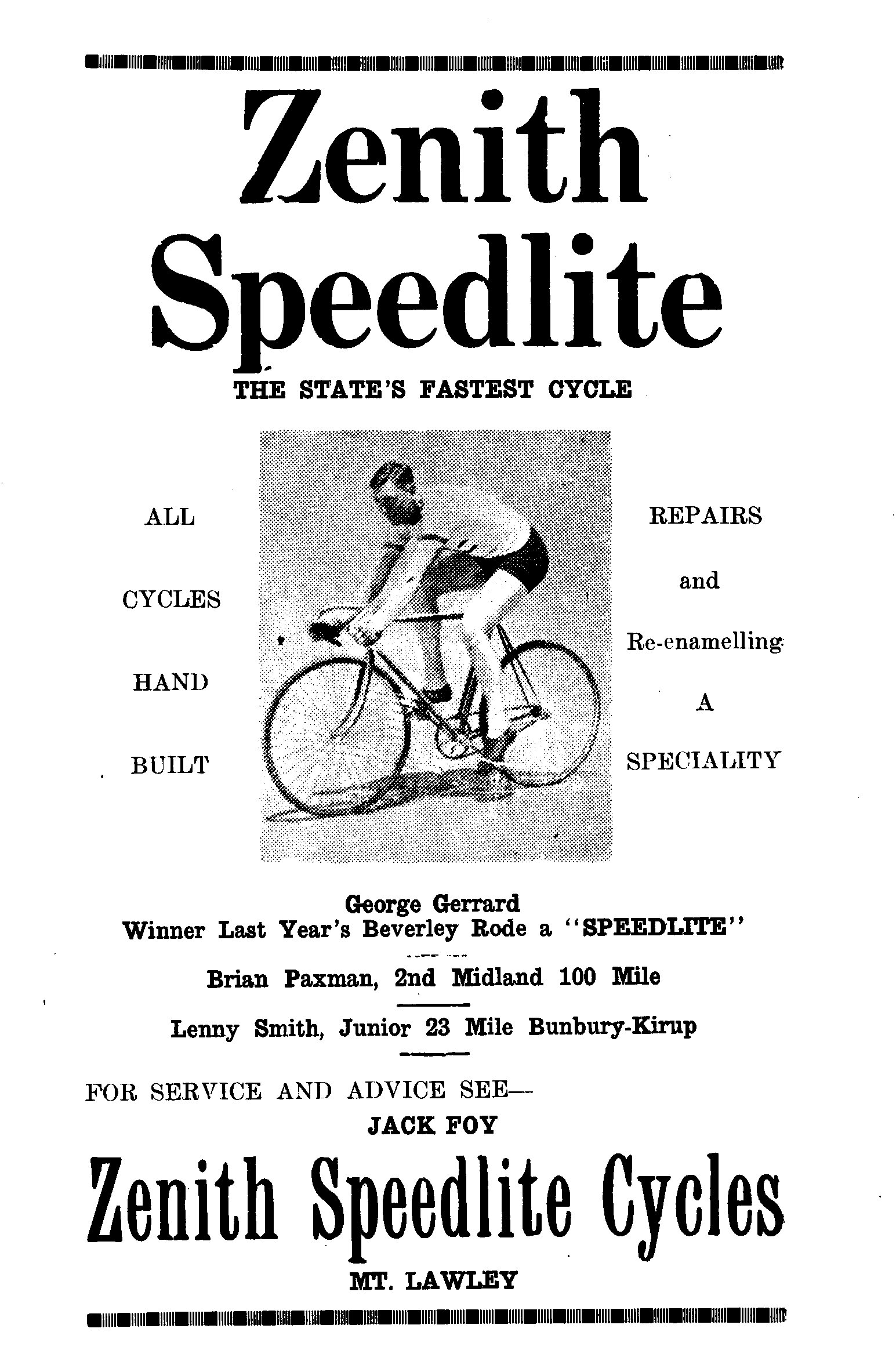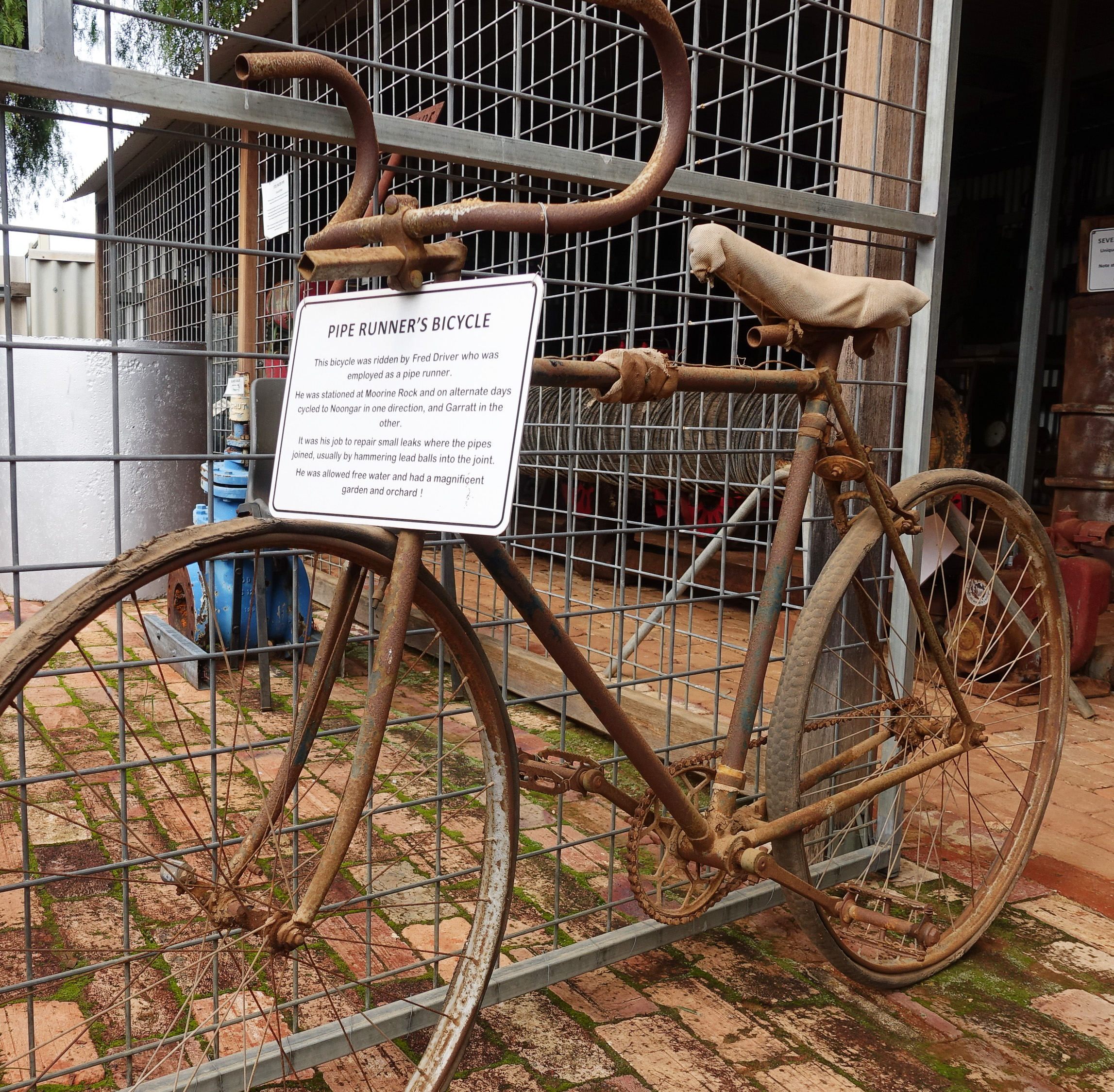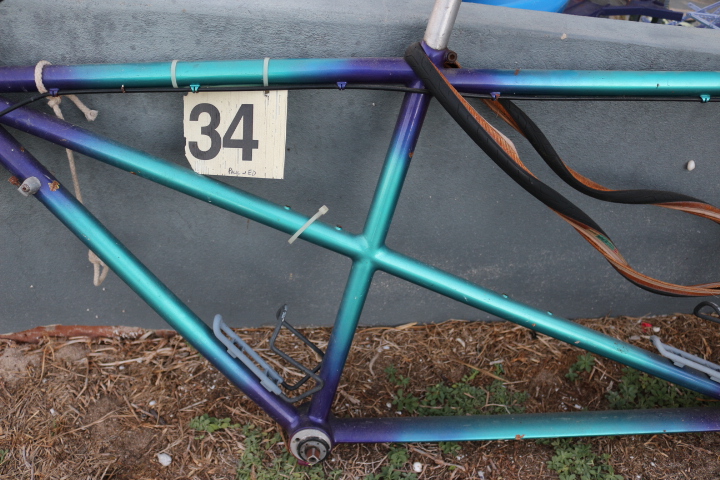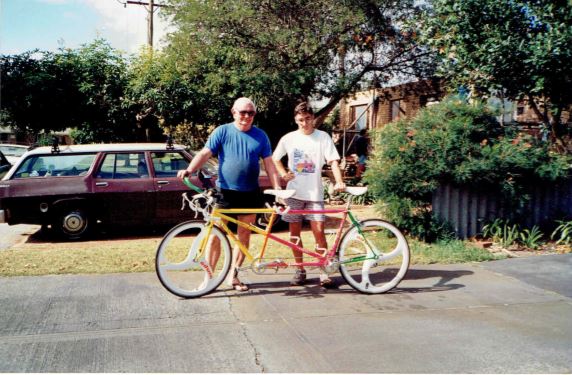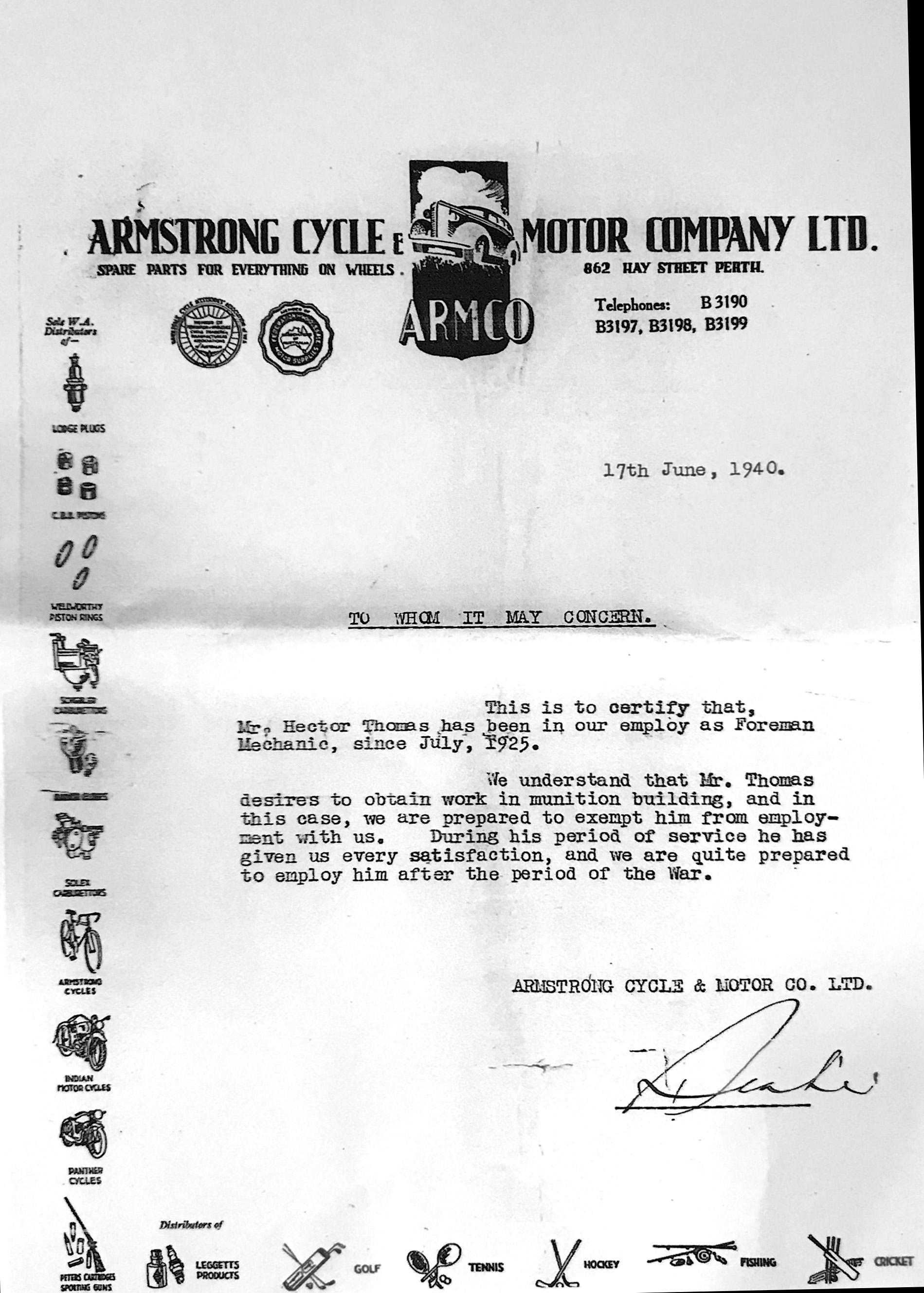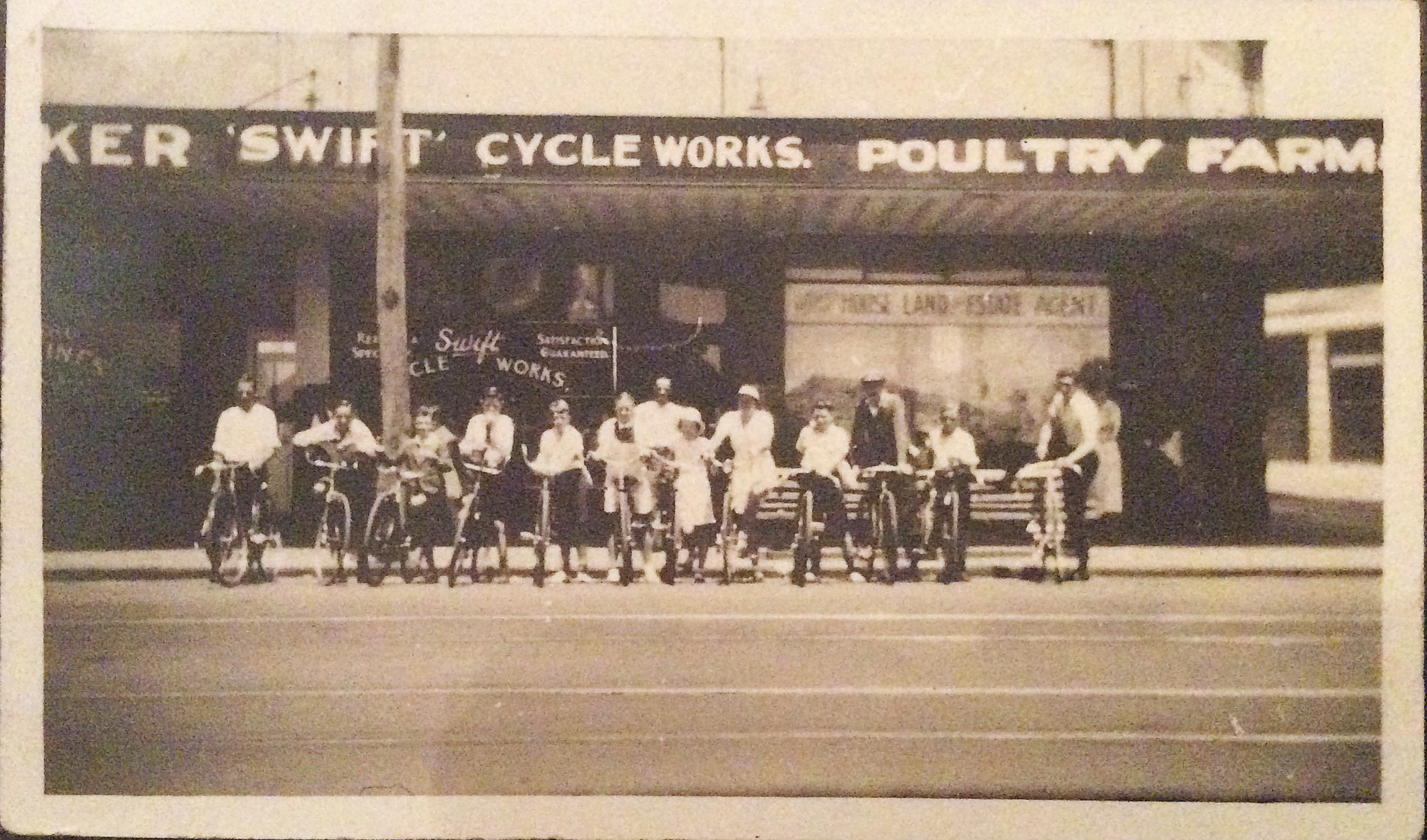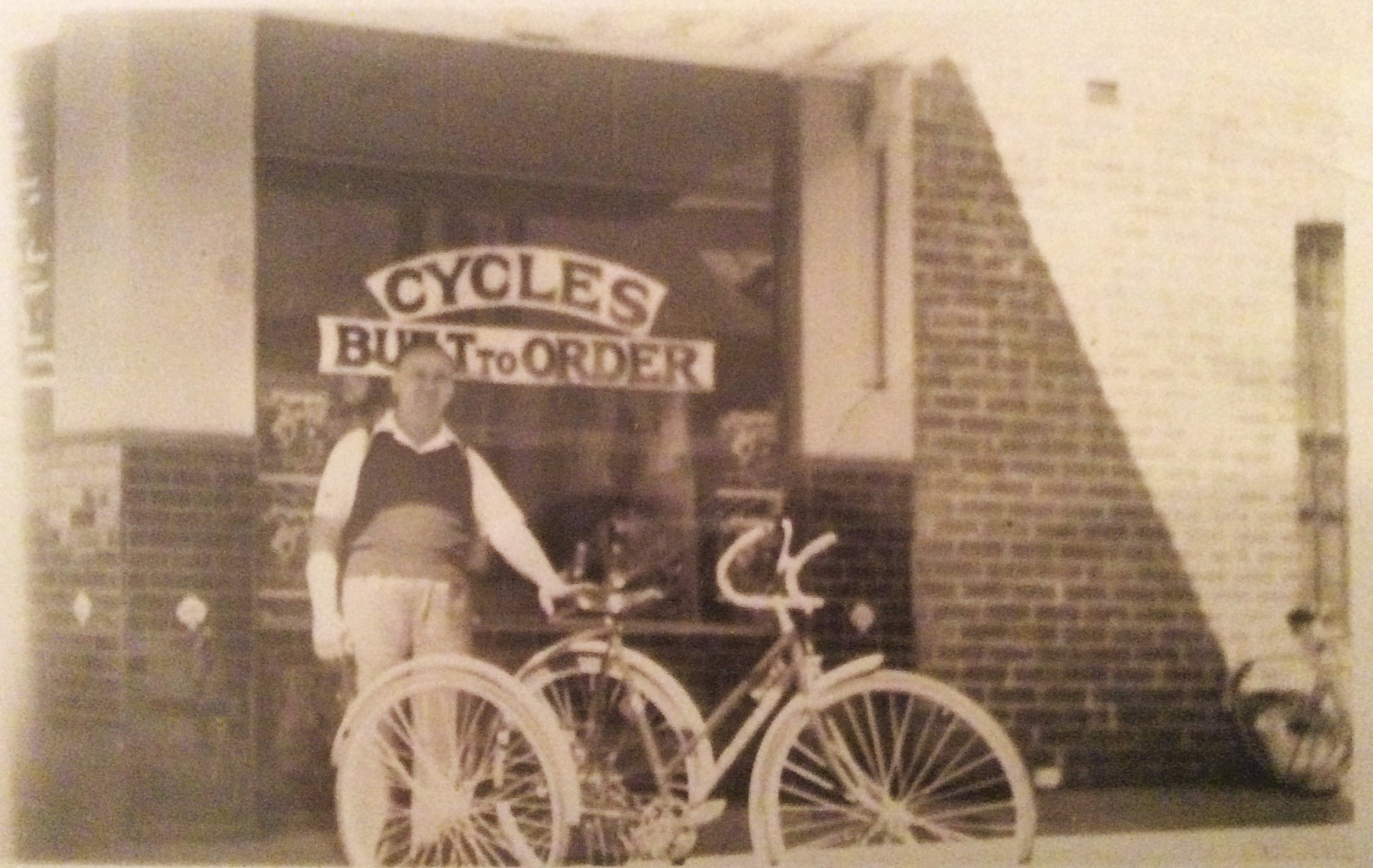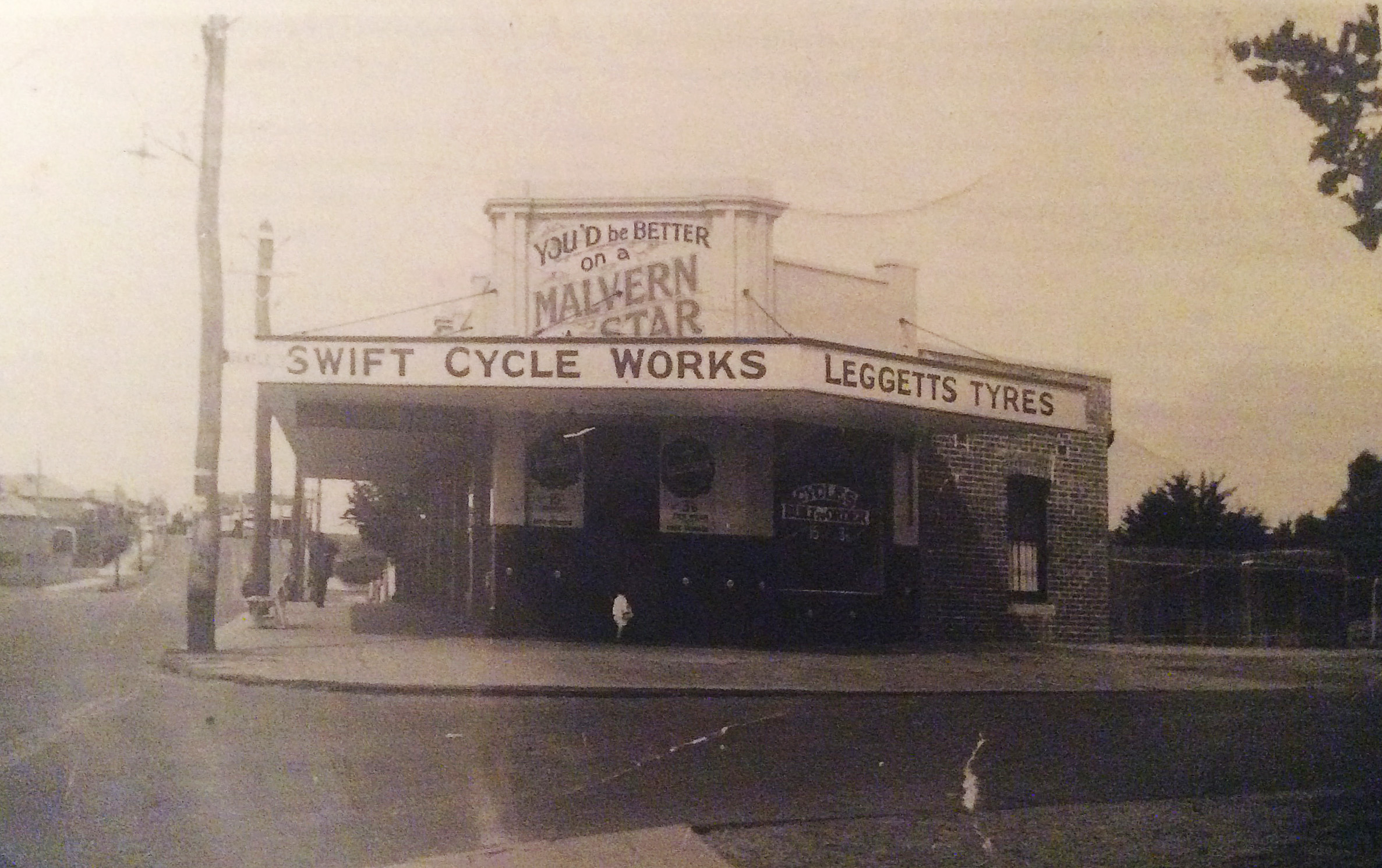Bill Taylor’s handwritten reminiscence was kindly provided by his daughter Gail McNab.
Born George William Henry Taylor he was known as Bill or Bluey from his army days. Bill and his brother Norrie rode and raced a lot. Bill came 3rd in the 1928 Beverley and 5th in 1936 and was still racing in the Collie Races until he was 92. He finally threw the towel in at 101 in 2017. He was healthy and sharp of mind until he passed. The photo is of Bill in 2010.
I started riding when I was 5 years old. My dad got this old bike from somewhere and gave it to me. I was thrilled to bits. Had to pump the tyres up about every 2 kilometres and the chain used to come off every so often. When I was 9 years old my dad showed me a piece of land - 3 acres - and said if I liked to clear it he would crop it for me. So I cleared it with a little help from Pat and De [sic]. I got $18 for my wheat and spent it all on my bike, a new chain, new tyres and tubes, new seat and new coat of paint. I was a millionaire and thrilled to bits. Could ride the 12 kilometres to Pop’s without stopping.
When I was 12 dad sold the farm and bought a small farm. 700 acres at East Pingelly. He built a house on it and we went to Petercarring [sic] school. I was very friendly with Bill Nairn. At Pop’s we used to ride a lot together. He came down to our farm to stay and we were going to ride to Pingelly, 15 kilometres away, but half way there I got a puncture. So we pulled the tyre off and got a heap of straw out of the paddock and rammed as much in the tyres as we could and rode home.
I left school when I was 13 and a half as it was depression time and things were hard. Dad had a clearing contract near Maurumbin [sic] so I went to work with him. I got no money, just my working clothes. So I didn't do much riding then.
I rode in my first show race when I was just 17. Borrowed Keith Hoad’s bike and I started from limit mark or front and won my first race. The next time I rode in the show race I was 20 and rode off scratch mark and won easily.
When I was 17 I got a job on a farm east of Kojonup for a dollar a week. I had a good bike by then so decided to ride to Kojonup. I left Pingelly at 3 o'clock in the morning and rode all day on corrugated gravel roads. I got to the farm at 5 o'clock and had rode 200 kilometres that day. My wrists were all swollen from the corrugations but I slept well that night.
I left Kojonup after a while and got a ride on a truck to Perth, my first trip to Perth at 17 and the first time I had seen the sea. I got a job between Wyalkatchem and Koorda but didn't stay long. I eventually got a job at Koorda with Jim Howe, an ex-Pingelly chap. I was pretty happy there until I went up to Bencubbin and rode in the show race. They decided to start a cycle club there. Also Norrie (brother Norrie Taylor) was working there so I moved to a job at Bencubbin and rode in some races there. On New Year's Day they had a race from Bencubbin to Gabbin. About 20 kilometres. Myself and another chap were sprinting to the finish for second place and the spectators got a bit excited and one chap stopped for a better view. My handlebars hooked in his pocket and ripped his trousers wide open. I crashed and smashed my front wheel and lost a lot of skin. They had another race around Gabbin. I was able to borrow a front wheel and finished second.
After harvest the chap I was with offered me a permanent job so I decided to go back to Pingelly for a holiday. I left his place at 3 o'clock in the morning and headed for Pingelly from Bencubbin to Tammin and then south towards Quairading.
Wasn't sure where I was so called into the farm and he was a bachelor about 15 kilometres from Quairading. He gave me a cuppa and a snack and also offered me a job on his farm that I didn't take. Could have been alright. He was going to town so gave me a lift to Quairading. I had very little money but had a cheque my boss had paid me. I tried to cash it at the hotel but they wouldn't cash it. I was dog tired and really hungry so went down to the railway yards, found a truck with a tarpaulin in it and wrapped the tarp around myself and spent the night there. I woke fairly early and headed for Pingelly. I eventually arrived at Aldersyde and found I still had 10 cents left.
I had no tea or breakfast but I was also very thirsty. I went into Ellingham's shop at Aldersyde and bought a bottle of cool which got me to Pingelly by midday. I had travelled 250 kilometres in a day and a half. I was a very tired and hungry boy.
I didn't ever go back to Bencubbin but got a job at Narembeen. This was in 1935. I found Narembeen the most friendly places I was ever at. I guess the fact that I played football and joined the cycle club made it easier. I went there as a complete stranger but soon got to know a lot of people. Used to go to a dance on Saturday night, go in and ride in a race Sunday morning, then play football on Sunday afternoon.
In those days every town in the wheatbelt a cycle club had. Today they are all gone. Each club used to have an annual track meeting with riders coming from everywhere, including top riders from Perth and Fremantle. During my stay at Narrabeen, I rode in track meetings at Kondinin, Narembeen, Bruce Rock and Merredin.
Because the top state riders were always there, I only ever got second places. I left Narembeen after 12 months and came back to Pingelly and rode off scratch there for about 3 years. Pingelly had an open road race one year. Some Perth riders came up including Ray Barron who had been W.A. Junior Champion.
I rode off scratch with him and I got first and fastest time. Well, his father was still lecturing him an hour later, where he lost ground and where he should have made up ground etc.
About this time I decided I would ride in the Beverley to Perth bike race. I was trapping rabbits for a living so did very little training. A fortnight before the race I stopped trapping so I could do some training. I was 20 years old and fairly fit. On the Tuesday before the race I decided to ride from Pingelly to Perth to see how I would go. Between Beverley and York [there was a group of riders] so I joined them. In that group was Ron Logue who won the year before and the father of that lass that wrote to me recently. Also John Riley who finished second.
John Riley also won two Collie-Donnybrooks during his riding career. We went to Perth on Tuesday, rode back to Beverley on Thursday where the Collie boys stayed. I rode on to Pingelly then back to Beverley on Friday, rode in the race on Saturday and back to Pingelly on Monday. Did about 800 kilometres that week.
I had a room in the hotel at Beverley on the Friday night and shared with the chap from Kalgoorlie. He was George Hebbard which didn't mean much to me until next day. He rode off scratch and punctured in the race, mended the puncture and still got fastest time which gave the title of W.A. Road Champion. Later on he was to have three sons play league football for West Perth so obviously they weren't interested in bike riding.
After the Beverley to Perth I made two trips back to Narembeen. 320 kilometres a trip. The last trip I did I rode into a howling wind from Corrigin and was about done. When I got there I walked into the Hotel. Some of the chaps I knew were there and said you look as though you could do with a beer. They handed me this nice cold beer and the next thing I woke up in a bed. A rather foolish thing to do.
I think most of what I did when I came back to riding is in my photos, but briefly, I rode with W.A. Vets for 7 years, I rode in two Northam to Perth’s, one Thornlie- Pinjarra & return, two Narrogin-Wagin and return, three different Rockingham races, numerous races in Perth Metro area, two Collie-Donnybrooks and return races, to Lowey Memorial races at Collie and three track meetings on Collie Velodrome. My first racing bike cost $3, my last one cost $800. Happy days.
P.S. I forgot to mention that before I rode in the Beverley to Perth my dad tried to talk me out of it as he said I wasn't fit enough. Then when I finished 5th out of 108 riders he was so pleased. When I got home he was so excited and couldn't stop shaking my hand. And my dad never got very excited about anything.

